With tendrils twisting into classical, jazz, blues, folk, psychedelia and avant-garde, the progressive branch of rock music takes the genre to its most unapologetically expressive bounds. Winding compositions weave a musical narrative, wherein delicate verses give way to frenetic stanzas interspersed with atmospheric, introspective passages—or pull an altogether different, equally unexpected turn.
Since progressive rock musicians tend to reference an encyclopedia of styles and influences, and they’re seldom shy about flaunting their vocabulary, sonic versatility is the key for most guitarists. Being able to change tones and textures from movement to movement is a prerequisite to telling a dynamic tale in prog rock fashion.
If you’re a guitarist who’s eager to begin blazing their own musical trail, this article should help you find some of the best gear for prog rock, including guitars, amplifiers and effects. Appropriately equipped, you can explore the shimmering cleans, far-out soundscapes, blues-rock bite and chewy saturation that have defined the genre and its offshoots for decades.

Pictured: Ibanez RG470PB Standard in Red Eclipse Burst
Table of Contents
Best Electric Guitars for Prog Rock
Comparing the Best Electric Guitars for Prog Rock
Best Guitar Amps for Prog Rock
Comparing the Best Guitar Amps for Prog Rock
Best Effects Pedlas for Prog Rock
Comparing the Best Effects Pedals for Prog Rock
Key Players and Featured Tracks
Careful With That Axe, Eugene
People Also Ask ...
Best Electric Guitars for Prog Rock
The colorful world of progressive rock has been painted with innumerable brushes and hues—there’s no definitive “prog rock” guitar. Whether you’re a traditionalist or a futurist, you can prog out just as well on a Stratocaster as you can a .strandberg*.
Keep an eye on things like pickup configuration, bridge style and overall playability, but don’t get too hung up on specs alone. The best guitar for prog rock will always, firstly, be the one that inspires you to pick it up and play.

Pictured: Fender Player II Limited-Edition Stratocaster with Maple Fingerboard in Black
Comparing the Best Electric Guitars for Prog Rock
|
Model |
Body |
Neck |
Fretboard |
Pickups |
Bridge |
Price |
|
Alder |
Maple |
Maple |
Player Series Alnico V Single-Coil Strat (SSS) |
2-point synchronized tremolo |
$799.99 |
|
|
Alder |
Maple |
Maple |
Player Series Alnico V Single-Coil Tele (SS) |
6-saddle string-through-body |
$799.99 |
|
|
Swamp ash |
Maple |
Ebony |
Early L500 Mojotone humbucker, overwound Mojotone single coils (HSS) |
Floyd Rose floating tremolo |
$3,999.00 |
|
|
Mahogany |
Mahogany |
Rosewood |
’60s Burstbucker (HH) |
ABR-1 Tune-O-Matic |
$2,799.00 |
|
|
Meranti |
Maple |
Jatoba |
Quantum (HSH) |
Edge-Zero II floating tremolo |
$599.99 |
|
|
Nyatoh |
Maple |
Rosewood |
Sterling by Music Man humbuckers (HH) |
Sterling by Music Man floating tremolo |
$599.99 |
|
|
Basswood |
Maple |
Maple |
.strandberg* Custom OEM pickups (HH) |
.strandberg* Rev7 fixed |
$1,645.00 |
Fender Player II Limited-Edition Stratocaster
Why It’s Proggy: Aesthetically recalling David Gilmour’s famous, self-modified “Black Strat” played on every Pink Floyd album and tour from 1970–1983, the limited-edition Fender Player II Stratocaster tips its cap to one of prog’s greatest legends and most iconic guitars.
Things to Consider:
- Sonically versatile trio of single coils with a 5-way pickup selector
- Comfortable 9.5" fretboard radius equally suits chording and soloing
- Smooth-feeling tremolo system with solid tuning stability

Shop Now: Fender Player II Limited-Edition Stratocaster with Maple Fingerboard in Black
The Fender Player II Stratocaster in a limited-edition glossy black finish—complete with a matching pickguard and aged white plastics—looks like it’s straight from Pink Floyd’s The Wall era circa 1979, after Gilmour swapped the guitar’s original neck and scratch plate. Fender’s current Player II Stratocaster continues to sound the part of a classic rock ’n’ roll electric, though its hotter pickups are voiced to engage with contemporary styles, too. Important upgrades to enhance playability include a Modern C neck profile with rolled fretboard edges and a slick satin urethane finish.
The Strat’s been around since 1954, and we know there’s a lot of information to digest. That’s why we’ve put together a piece on How to Buy the Best Stratocaster to demystify the process for prospective shoppers.
Fender Player II Telecaster
Why It’s Proggy: In Pink Floyd’s early years, cofounder, primary songwriter and frontman Syd Barrett played a Fender Esquire to explore psychedelic rock musings.
Things to Consider:
- Pair of Telecaster single coils with increased output
- Satin-finished maple neck with 9.5" fretboard radius
- Optimized intonation and stability from a six-saddle bridge

Shop Now: Fender Player II Telecaster with Maple Fingerboard in Black
A passing glance at famous Telecaster players tells you everything you need to know about the guitar’s tonal range: Keith Richards, Tom Morello, Jeff Buckley, George Harrison, Jonny Greenwood, Jeff Beck, Prince … the list goes on. A perfect platform for prog rock and more, the Fender Player II Telecaster offers the articulate bite and rich warmth that have made the instrument a cross-genre mainstay, and its effortless in-hand feel appeals to players of all stripes. In more recent progressive rock times, Steven Wilson’s then-newfound affinity for the Telecaster defined the guitar tones on his 2017 solo effort To the Bone.
Still wondering which Tele is right for you? Visit our Guide to the Fender Telecaster to learn everything you need to know about the legendary silhouette.
Godin Lerxst Grace
Why It’s Proggy: Alex Lifeson’s signature Godin Lerxst Grace is a reimagined version of his Hentor Sportscaster from Rush’s mid-’80s Grace Under Pressure period.
Things to Consider:
- Locking Floyd Rose system enhances tuning stability and enables expressive bends
- Fast-playing ebony fretboard with 12" radius and 22 medium stainless steel frets
- HSS pickup configuration with simplified electronics (volume, tone, 3-way toggle)

Shop Now: Godin Lerxst Grace with Floyd Rose in Red
The Godin Lerxst Grace is a high-performance Superstrat-style electric guitar built to the exacting specifications of progressive rock icon Alex Lifeson. Featuring a comfortably contoured, lightweight swamp ash body with a bolt-on maple neck, the guitar is snappy and responsive to all dynamic input it receives. Plus, its HSS pickup layout—with a Bill Lawrence-inspired Early L500 Mojotone humbucker in the bridge—covers all tonal bases, from gained-up growl to bell-like cleans.
Gibson Les Paul Standard '60s Figured Top
Why It’s Proggy: The Gibson Les Paul Standard is simply one of the finest rock guitars ever produced, with a time-honored voice that fits in anywhere.
Things to Consider:
- SlimTaper neck profile with medium-jumbo frets and 12" fingerboard radius
- Handwired electronics use Orange Drop tone control capacitors
- Lovely AA figured maple top
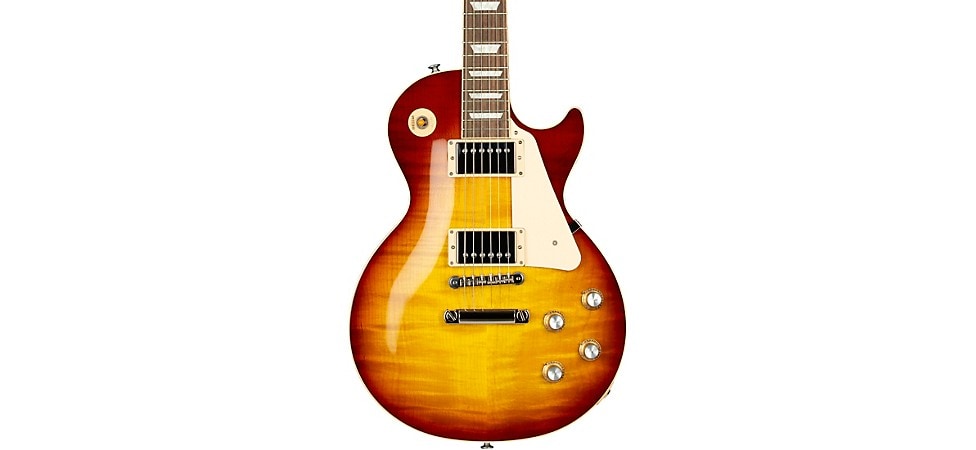
Shop Now: Gibson Les Paul Standard '60s Figured Top in Iced Tea
Honoring Gibson’s Golden Era, the Les Paul Standard ’60s Figured Top electric guitar captures the essence of treasured early 1960s models that have shaped the sound of rock ’n’ roll for generations. In prog/experimental circles, Steve Hackett, Robert Fripp, Alex Lifeson and Frank Zappa have all wielded the timeless Les Paul, along with other iconic rockers like Jimmy Page, Duane Allman, Mick Ronson and Billy Gibbons. The Les Paul Standard’s low action, 24.75" scale length and 12" radius combine for no-sweat fretboard navigation, easy bends and comfy chording.
The best-selling Gibson Les Paul Standard ’60s electric is a top-rated model at Guitar Center, earning 4.8/5 stars on 75+ ratings.
Also, if you lean toward the heavier side of progressive music, Gibson makes an Adam Jones Les Paul Standard based on the Tool guitarist’s favorite late-’70s Silverburst Customs. It even scores a 5-star rating among Guitar Center customers.
Curious about other members of the Paul family? How to Choose the Best Gibson Les Paul has you covered.
Ibanez RG470PB Standard
Why It’s Proggy: Whether you play progressive metal, rock, fusion or shred, the performance-oriented Ibanez RG470PB Standard is prepared for it all.
Things to Consider:
- HSH pickup configuration and 5-way blade provides tons of tonal variety
- Thin, flat 15.75"-radius Wizard III neck facilitates fretboard fluidity
- Low-profile Edge-Zero II bridge virtually disappears under your hand

Shop Now: Ibanez RG470PB Standard in Red Eclipse Burst
More than just a hard-rocking shred machine, the Ibanez RG470PB Standard’s elite playability and tonally diverse pickup palette attracts players of many styles, which is precisely why it’s such a great progressive rock guitar. With the ability to go from aggressive high gain to split-coil cleans to pillowy neck-position leads and back, the Ibanez RG470PB handles any sound you can throw at it. One Guitar Center customer from Jackson, MS, was “blown away by the neck, the action and tones you can get” from the RG470PB.
The Ibanez bloodline runs deep—for an in-depth look at some of their top offerings, check out the Best Ibanez Guitars for Metal.
Sterling by Music Man John Petrucci JP60
Why It’s Proggy: Following the footsteps of his flagship EBMM JP6 signature, the Sterling by Music Man John Petrucci JP60 brings an iconic design to players on any budget.
Things to Consider:
- Locking tuners and proprietary floating tremolo promote pitch stability
- Ergonomically shaped body with a deep forearm carve
- JP Shield logo inlay at the first fret
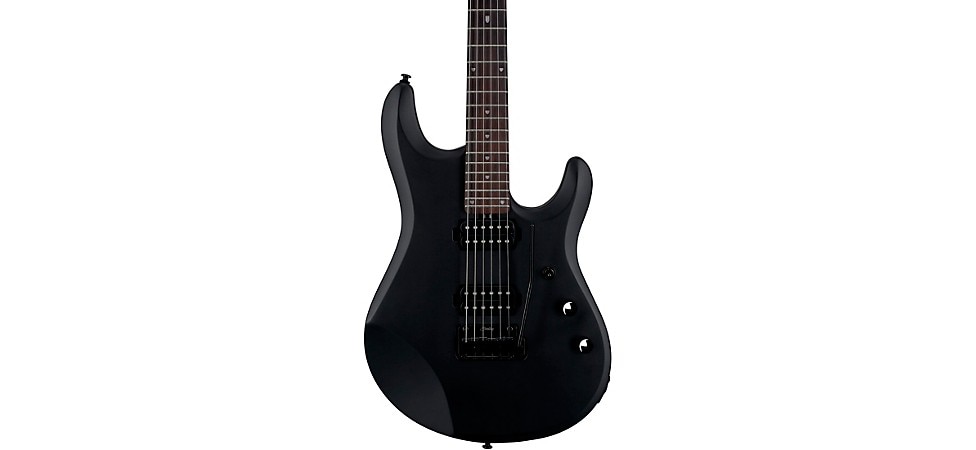
Shop Now: Sterling by Music Man John Petrucci JP60 in Stealth Black
Dream Theater and Liquid Tension Experiment’s John Petrucci is a prog metal hero, oft regarded as one of the most technically accomplished guitarists on the planet. The Sterling by Music Man John Petrucci JP60 can’t promise his chops, but it incorporates shred-ready specs like a flat 16" fingerboard radius and 24 medium-jumbo frets. Sleekly contoured, the Stealth Black JP60 offers a softer silhouette than other all-black “metal” guitars, so it always looks (and most importantly, sounds) the part, whether you’re rifling through high-octane riffs and speeding after white-hot solos, or holding down clean chord progressions and forming an effects-drenched psychedelic soundscape.
Mike from New Kent, VA, confirmed in a Guitar Center review, “This guitar is great for metal, jazz, cleans or really any style. It’s on par with guitars that are twice the price. It plays and feels great.”
.strandberg* Boden Standard NX 6
Why It’s Proggy: Played by the likes of Plini, Sarah Longfield, Per Nilsson, Jacob Collier, Owane and Jordan Rudess, .strandberg* guitars embody the innovative spirit of the modern musical vanguard.
Things to Consider:
- Patented EndurNeck profile with squared edges
- Weighs an extremely slight 5 lb.
- Gorgeous flamed maple veneer

Shop Now: .strandberg* Boden Standard NX 6 in Charcoal
The .strandberg* Boden Standard NX 6 headless electric is practically a call sign for contemporary prog players. Head-spinningly compact and lightweight, the ergonomic .strandberg* form promotes relaxed playing posture and a natural connection to the instrument. Voiced for progressive rock and metal, expect clean, mean and everything-in-between tones from a pair of proprietary humbuckers and a 5-way pickup selector.
Best Guitar Amps for Prog Rock
Amplifiers form the foundation of your tone. Multi-channel and pedal-platform amps work really well for prog rock and metal, delivering more than one sound out of the box and/or the option to stack stompboxes and build out custom effect combos. If an amplifier has a few onboard effects, even better, as that’ll let you experiment with textures right away and reach your tone goals a little bit faster.

Pictured: Roland JC-40 Jazz Chorus 40W 2x10 Combo Amp
Comparing the Best Guitar Amps for Prog Rock
|
Model |
Type |
Wattage |
Channels |
Speakers |
Features |
Price |
|
Modeling combo |
100W |
4 |
Custom BOSS 12" |
6 amps, 15 effects, effects loop, line out, headphone out, AUX in, USB-C |
$399.99 |
|
|
Tube combo |
22W |
2 |
12" Jensen C-12K |
Reverb and tremolo (“vibrato”) |
$1,699.99 |
|
|
Tube combo |
40W |
2 |
12" Celestion G-12 V-Type |
Reverb, effects loop, speaker emulated output |
$729.99 |
|
|
Tube combo |
90W |
3 |
12" Celestion Custom 90 |
Reverb, effects loop, graphic EQ, CabClone IR |
$3,849.00 |
|
|
Tube head |
50W |
2 |
N/A |
Reverb, effects loop, attenuator |
$2,299.00 |
|
|
Solid-state combo |
40W |
1 |
Two custom-designed Roland 10" |
Chorus, vibrato, reverb, distortion, effects loop, line out, headphone out, stereo input |
$699.99 |
|
|
Tube combo |
15W |
1 |
12" Celestion G12M Greenback |
Reverb, tremolo, Normal and Top Boost inputs |
$849.99 |
BOSS Katana-100 Gen 3
Why It’s Proggy: The BOSS Katana-100 Gen 3 combo is a tonally versatile beast for writing, practice, recording and gigging.
Things to Consider:
- Six onboard amp types with an additional variation each (12 total)
- Five simultaneous effects blocks with three variations each (15 total)
- Connects to the BOSS Tone Studio to unlock up to 60 effects and more sound-shaping tools

Shop Now: BOSS Katana-100 Gen 3 100W 1x12 Combo Amp
Modeling amplifiers like the BOSS Katana-100 Gen 3 are amazing for prog rock, in that they’re extremely adaptable sonically, letting you explore a range of sounds not normally found in a “regular” amp. The Katana-100 offers six Tube Logic-modeled amp characters: Acoustic, Clean, Pushed, Crunch, Lead and Brown. Each has been digitally reproduced to mimic complex tube circuitry and capture the sound and feel of its valve-driven equivalent. From here, you can layer Booster, Mod, FX, Delay and Reverb blocks to create comprehensive tone presets, storing eight of your favorite go-to sounds.
At Guitar Center, players love the flexibility and convenience of the BOSS Katana-100 Gen 3 combo, rating it 4.9/5 stars after 15+ reviews.
Fender Vintage Reissue '65 Deluxe Reverb
Why It’s Proggy: The Fender Vintage Reissue ’65 Deluxe Reverb takes your tone back to prog rock’s mid-’60s genesis.
Things to Consider:
- Two channels and four inputs (two Normal, two Vibrato)
- Lush, tube-driven spring reverb goes from subtle to cavernous
- Includes two-button footswitch
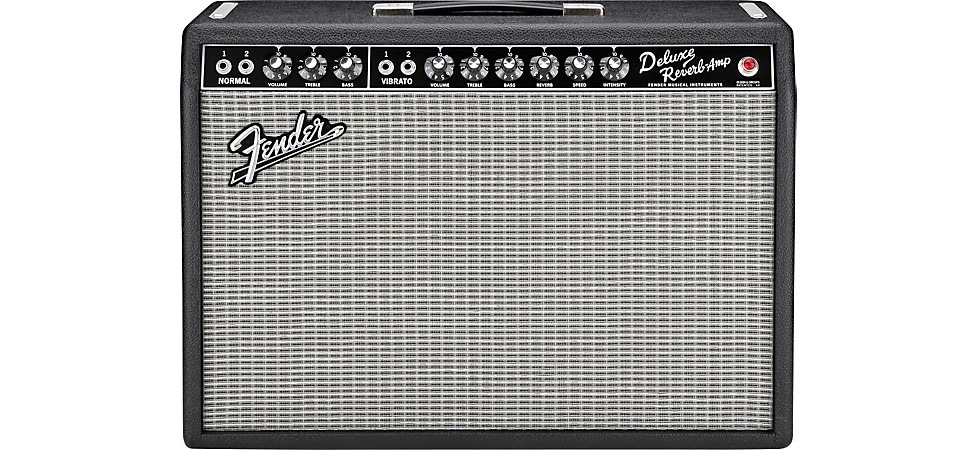
Shop Now: Fender Vintage Reissue '65 Deluxe Reverb Combo Amp
The Fender Vintage Reissue ’65 Deluxe Reverb combo captures the timeless tone of one of the most popular amps in history—a true studio workhorse featured on innumerable hit recordings and a faithful stage companion heard around the world. Popular among blues, rock and country players, the Deluxe Reverb is also a stellar prog amp when you need legendary Fender cleans and gritty pushed tones. Onboard reverb and tremolo then add some instant dimension to your sound from the jump.
The top-rated Fender Vintage Reissue ’65 Deluxe Reverb scores 4.8/5 stars on 95+ reviews. On its versatility and sound quality, Zeke from Chicago, IL, shared “The ’65 Deluxe Reverb remake is simply the best-sounding amp I’ve ever played. I play classic rock, jazz, blues and some world music. It excels, and I mean excels, in every context. Warm, articulate and clean, and the breakup is just so silky. If you’re on the fence, take the jump.”
How to Choose the Best Fender Guitar Amplifier has even more insight on the iconic brand’s catalog.
Marshall DSL40CR
Why It’s Proggy: With two channels and two distinct profiles each, the Marshall DSL40CR tube combo offers coveted British-style tone with the adaptability prog rock players require.
Things to Consider:
- Power scaling from 40W down to 20W
- Classic and Ultra Gain channels (with Clean/Crunch and OD1/OD2 modes)
- Onboard digital reverb with independent, per-channel level

Shop Now: Marshall DSL40CR 40W 1x12 Tube Combo Amp
Powerful and compact, the Marshall DSL40CR tube combo sonically covers clean, crunch and high-gain territory, so you can navigate all the movements of your latest progressive rock or metal masterpiece. A handy half-power mode helps manage levels, while also decreasing the amp’s headroom for hairier clean or crunch tones with more organic breakup. Plus, you can hook up your pedalboard to the built-in effects loop or connect loudspeaker expansions using five dedicated outputs. A player favorite at Guitar Center, the best-selling Marshall DSL40CR tube combo is graded 4.4/5 on 135+ reviews.
MESA/Boogie Mark VII
Why It’s Proggy: MESA/Boogie Mark Series amps are the brand’s most tonally diverse offerings, with none other than John Petrucci adopting the Mark IIC+ early on before developing his own signature JP-2C.
Things to Consider:
- Three-channel, nine-mode preamp section
- Channel-assignable 25, 45 and 90W power settings
- Footswitchable, channel-assignable 5-band graphic EQ

Shop Now: Mesa/Boogie Mark VII 90W 1x12 Tube Combo Amp
The MESA/Boogie Mark VII was released in 2023 and touted as the “magnum opus” of Randall Smith’s decades-spanning career as an innovative visionary in the world of guitar amplification. This 90W combo is the smallest (and most versatile) entry the Mark Series has ever seen, featuring three channels and nine modes, with voices including Clean, Fat, Crunch, MKIIB, MKIV, MKVII and IIC. The tonal possibilities are truly staggering thanks to per-channel power scaling, a graphic equalizer and classic tone stack EQ, and onboard reverb, making the MESA/Boogie Mark VII a phenomenal amp for the diverse needs of prog rock and metal.
For more, check out our guide on How to Choose the Best MESA/Boogie Guitar Amplifier.
Orange Amplifiers Rockerverb 50 MKIII
Why It’s Proggy: The Rockerverb was Orange Amp’s first foray in high-gain territory, and while it absolutely appeals to heavy rockers, its overall versatility makes it an excellent choice for the many flavors of prog.
Things to Consider:
- Post-master attenuation circuit reduces volume without compromising tone
- Half-power (25W) mode for easier tube saturation
- Classic British tone and iconic Orange aesthetics
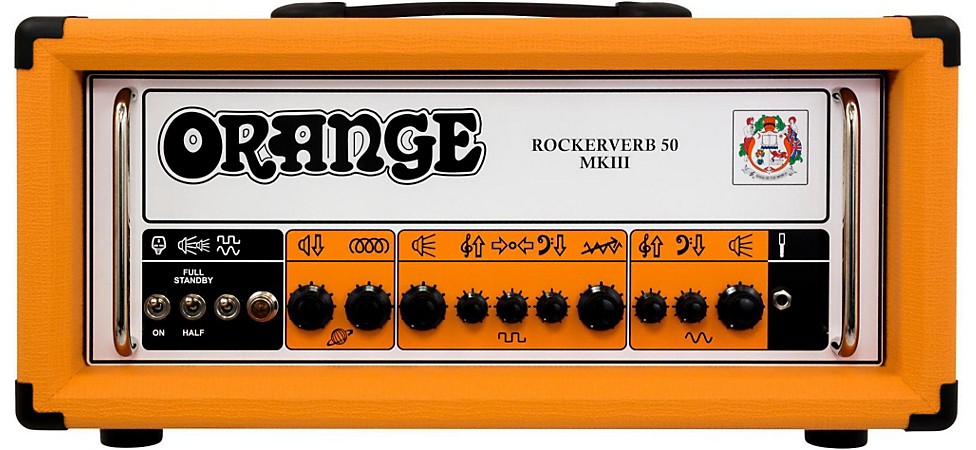
Shop Now: Orange Amplifiers Rockerverb 50 MKIII 50W Tube Amp Head
The Orange Amplifiers Rockerverb 50 MKIII tube head is a dual-channel design destined for pristine cleans, classic rock crunch and ferocious high gain—all of which maintain exceptional clarity and articulation. Besides its rousing tone, the Rockerverb MKIII’s coolest feature may just be its built-in attenuator. Located after the master volume in the signal path, you can drive the valves to organic breakup, then dial the entire output down with the attenuator to ensure the amp’s viability at home, in rehearsal, on stage or in the studio. Pair the Rockerverb MKIII head with a matching Orange PPC212OB speaker cabinet and prepare to blow doors down (or gently knock on them—attenuator, remember?).
One Guitar Center reviewer from Portland, OR, described the Rockerverb as “very articulate and detailed” with an “awesome clean channel [that’s] bright and punchy.” In short, “this amp does it all.”
Roland JC-40 Jazz Chorus
Why It’s Proggy: Roland’s renowned JC-40 Jazz Chorus features one of the best baseline, pedal-platform clean tones around, in addition to its signature stereo chorusing effect.
Things to Consider:
- Lush, immersive, stereo Dimensional Space Chorus
- Onboard vibrato, distortion and reverb
- Iconic “JC clean” sound is ideal for building a pedal-driven rig
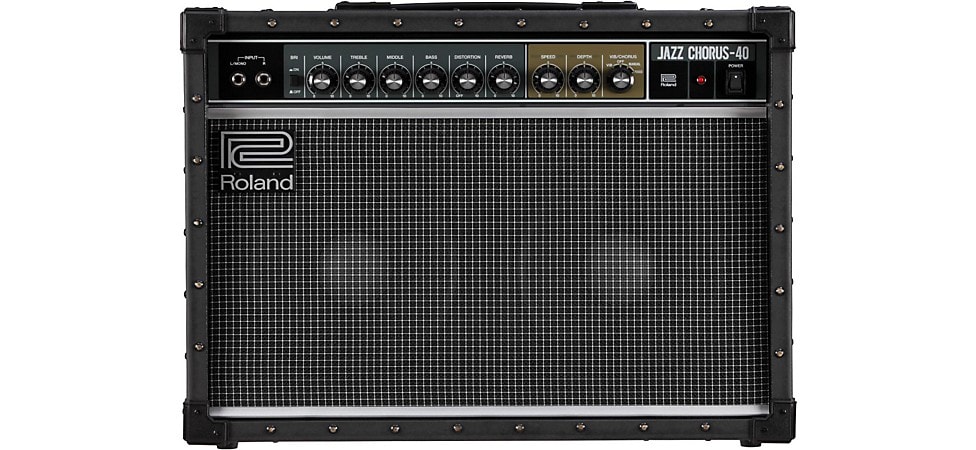
Shop Now: Roland JC-40 Jazz Chorus 40W 2x10 Combo Amp
Prog guitarists who’ve embraced the Roland Jazz Chorus at points in their career include Robert Fripp, Adrian Belew, Steve Hackett and Steve Rothery (Marillion), in addition to Andy Summers, Robert Smith, Johnny Marr, Joe Strummer and Prince. Plain and simple, the JC-40 Jazz Chorus sets the benchmark for clean guitar tones—immerse yourself in the amp’s famed stereo chorus, vibrato and reverb, or plug in your pedalboard and enter a universe of sound at your feet.
The Roland JC-40 Jazz Chorus is popular at Guitar Center, racking up 4.6/5 stars on 40+ reviews. For even more power and headroom, check out the Roland JC-120 Jazz Chorus.
VOX AC15 Custom Limited-Edition
Why It’s Proggy: The VOX AC lineup’s bright, jangly cleans and biting overdrive defined the sound of the British Invasion, and its touch-sensitive dynamic response lets guitarists control the sound with their hands.
Things to Consider:
- Normal (darker, less gain) and Top Boost (brighter, more gain) inputs
- Spring reverb and tremolo built in
- Limited-edition blue/cream color scheme

Shop Now: VOX AC15 Custom 15W Limited-Edition Tube Combo Amp in Blue/Cream
Like the Fender Deluxe Reverb, the VOX AC15 Custom in limited-run blue/cream is one of rock’s most influential amplifiers. Sporting a single-channel, dual-input design, the legendary Top Boost jack provides crisp, clear cleans along with cutting old-school crunch. Super dynamically responsive, the VOX AC15 responds well to volume knob adjustments on the guitar and a player’s pick attack, with an impressive amount of aggression from a “vintage”-voiced amplifier. As a top-reviewed best-seller at Guitar Center, the VOX AC15 has a cumulative tally of 4.8/5 on over 120 ratings.
Best Effects Pedals for Prog Rock
We now arrive at a smattering of effects pedals to give your prog rock guitar rig additional shape and character. If an amplifier is the footing of your tone and the guitar itself is the framework, pedals are the interior decoration. They dress up your sound and give it personality, and ultimately, these stylistic preferences are entirely decided by what you hope to hear.

Pictured: ProCo RAT2 Distortion Pedal
Comparing the Best Effects Pedals for Prog Rock
|
Model |
Effect Type |
Controls |
Power Supply and Draw |
Price |
|
Octave |
–2, –1, +5th, +1, +2, Dry, Attack, Filter, Detune |
9VDC, 500mA |
$645.00 |
|
|
Multi-effects |
Single-knob interface with Hotknob, X, Y, Z and Presets buttons |
9VDC, 500mA |
$649.00 |
|
|
Overdrive |
Drive, Tone, Level |
9VDC, 8mA |
$99.99 |
|
|
Fuzz, delay and modulation |
Level, Blend, Depth, Rate, Filter, Fuzz, Delay/Modulation switch, Fuzz voice switch |
9VDC, 75mA |
$299.00 |
|
|
Fuzz, pitch shifting and octave |
Blend, Fuzz, Level, Pitch, Tone, Pitch mode switch, Fuzz tone switch |
9–18VDC, 150mA |
$249.00 |
|
|
Distortion |
Distortion, Filter, Volume |
9VDC, 2mA |
$69.00 |
|
|
Delay |
Rec Level, Mechanics, Low Cut, Wear, Repeats, Echo Level, Spacing, Spring, Delay type toggle, Speed toggle |
9VDC, 300mA |
$429.00 |
Electro-Harmonix POG3 Poly Octave Generator
Why It’s Proggy: The most powerful Poly Octave Generator in the lineup, EHX’s POG3 can imbue your guitar tone with synth-like textures.
Things to Consider:
- Four-octave range and ultrafast tracking
- Dedicated pan knobs to create immersive stereo sounds
- 100 onboard presets for plug-and-play inspiration
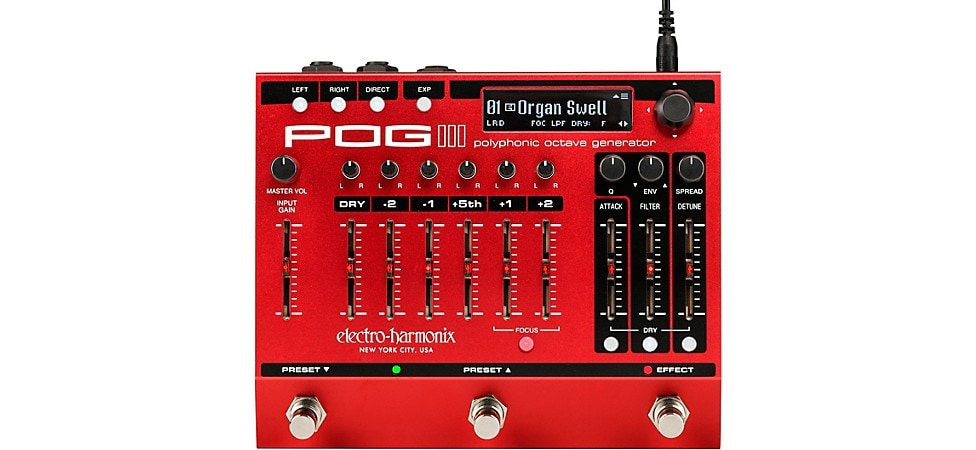
Shop Now: Electro-Harmonix POG3 Poly Octave Generator Effects Pedal
The Electro-Harmonix POG3’s transformative capabilities can turn your guitar into a jangly 12-string, a bass synthesizer, an organ, a swelling pad and more. With four octaves and a harmonizing perfect fifth thrown in for good measure, there’s an impressive amount of sonic ground to uncover as you hunt for thrilling new sounds to ignite a creative spark. Intuitively laid out, mini faders are assigned to each parameter for you to take hands-on control over the signal from the moment the POG3 hits your board. Powerful and easy to use, the EHX POG3 Poly Octave Generator effects pedal can be as unearthly or as ordinary as you want.
Looking for a different type of octave pedal? Check out our guide to The Best Octave Pedals.
Eventide H9 MAX Harmonizer Multi-Effects Pedal
Why It’s Proggy: Eventide’s H9 MAX Harmonizer runs every algorithm from the brand’s TimeFactor, ModFactor, PitchFactor and Space pedals, plus a handful of unique algos.
Things to Consider:
- 10 H9-exclusive effects for 52 total algorithms and 99 onboard presets
- Connects to the H9 Control app for 500 additional presets and advanced editing
- Recipient of a NAMM TEC Award in 2016

Shop Now: Eventide H9 MAX Guitar Multi-Effects Pedal
Loaded with reverb, delay, modulation and pitch-shifting algorithms, the Eventide H9 MAX Harmonizer multi-effects pedal is a wonderland for sound design and creative tone-sculpting. Belying its simplistic exterior are 52 individual effects, from everyday staples like tape delay, chorus and spring reverb to experimental generators, such as HotSawz (synthesizer) and Harmadillo (harmonic tremolo). Catering to the individual needs of artists across genres, Annie Clark (St. Vincent), Chris Traynor (Bush, Blur), Dweezil Zappa and Munky (Korn) are among the guitarists who regularly employ the Eventide H9 MAX Harmonizer.
Looking for more all-inclusive solutions to tone processing? Our article on the Best Multi-Effects Pedals shines light on the brightest options.
Ibanez TS9 Tube Screamer
Why It’s Proggy: The classic Ibanez TS9 Tube Screamer is perfect for bluesy crunch, pushing your amp into liquid overdrive and tightening up high-gain progressive metal tones.
Things to Consider:
- Timeless Tube Screamer tone
- No-nonsense control layout is easy to dial in
- Stacks well with other drive pedals in front of an amp’s clean channel

Shop Now: Ibanez TS9 Tube Screamer Effects Pedal
The Ibanez TS9 Tube Screamer overdrive pedal is a faithful reissue of the iconic circuit that’s been a pedalboard pillar since 1982. Blues, country, indie, rock and metal guitarists all call on the Tube Screamer when their amps need a little sweetening sizzle. As an always-on effect, progressive metal guitarists love to boost their high-gain amplifiers with a Tube Screamer to firm up the low end and make the midrange more aggressive—common settings are Level and Tone around 2:00 (or to taste) and Drive at zero, or barely on. For all other applications, the Ibanez TS9 Tube Screamer serves smooth saturation and singing sustain.
An incredibly popular overdrive pedal at Guitar Center, the TS9 sits at 4.77/5 stars with 125 reviews and counting.
On the hunt for more overdrive pedals? Check out our guide to The Best Overdrive Pedals.
Keeley Dark Side Multi-Effects Pedal
Why It’s Proggy: Dark Side by Keeley is a multi-effects workstation channeling serious David Gilmour vibes as an all-in-one tribute to that album.
Things to Consider:
- Analog fuzz circuit feeds DSP-driven delay and modulation side
- Multi-head tape echo emulator with 12 selectable configurations
- Four-part modulation section: Flanger, Rotary Speaker Cabinet, U-Vibe, Phaser

Shop Now: Keeley Dark Side Multi-Effects Pedal
The Keeley Dark Side multi-effects pedal combines ’70s-style op-amp fuzz, tape delay and old-school modulation to capture the essence of some of progressive rock’s most celebrated sounds. On the fuzz side, the sound is thick and wooly, increasing sustain while staying transparent enough to preserve the nuanced tone coming from the instrument’s pickups and your amp. From there, choose between 12 syncopated, rhythmic tape delays, or blend between the provided modulation selections to discover weird and wonderful textures. The Keeley Dark Side multi-effects pedal is a prog rocker’s dream machine.
Keeley Octa Psi Transfigurating Fuzz
Why It’s Proggy: Pitch shifting, fuzz and octave generation come together to fuel your wildest psychedelic rock fantasies with the Keeley Octa Psi Transfigurating Fuzz pedal.
Things to Consider:
- Place octave/pitch before or after the fuzz section
- Wet/dry Blend knob for subtle or extreme textures
- All-analog, transistor-based fuzz circuit

Shop Now: Keeley Octa Psi Transfigurating Fuzz Effects Pedal
For mind-melting tone made easy, look no further than the Keeley Octa Psi Transfigurating Fuzz pedal. Merging polyphonic pitch shifting, octave generation and Big Muff-inspired fuzz, the combo is as adept at down-tuned doom riffs as it is at spacey, psychedelic meanderings. The pitch shifter and octave generator provide eight modes based on harmonic intervals, along with an Up, Down and Dual switch for a total of 24 distinct characteristics. By holding down the fuzz footswitch, you can also swap between momentary or latching octaves, whether to emphasize a particular note or section, or leave on as an inherent part of your progressive sound.
If you're searching for another fuzz pedal to add to your collection, or looking for your first one, read our guide to The Best Fuzz Pedals.
ProCo RAT2 Distortion
Why It’s Proggy: Released in 1978, the original ProCo RAT made waves and has since become one of the best-selling effects pedals ever made.
Things to Consider:
- Dead-simple control layout
- Ultrarugged steel enclosure
- Pure analog signal path
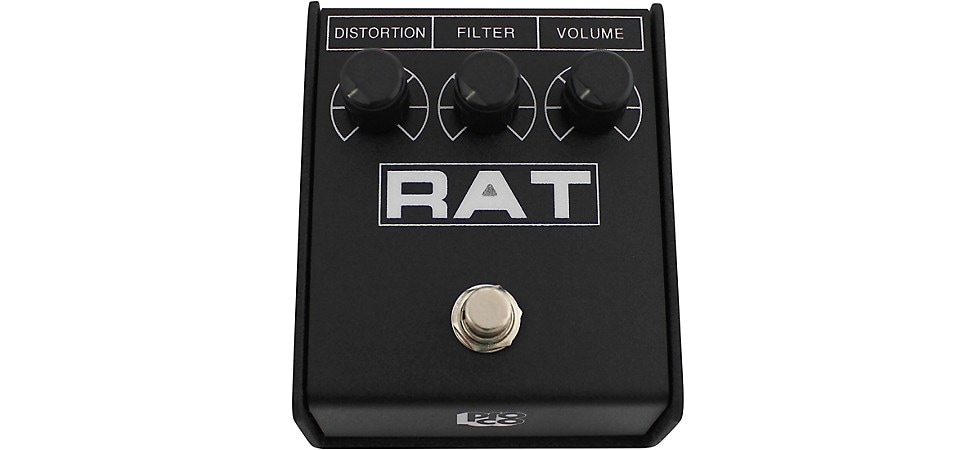
Shop Now: ProCo RAT2 Distortion Pedal
The ProCo RAT2 is such a versatile dirt pedal that folks often wonder, “Is it a fuzz or a distortion?” The answer? “Yes.” Used by everyone from James Hetfield and Kirk Hammett to Thom Yorke and Jonny Greenwood, and from David Gilmour (there’s that name again) to Graham Coxon, the RAT is the definitive distortion pedal, regardless of the style you play. Edgy overdrive, tube-like saturation and frothy fuzz—the ProCo RAT2 effortlessly manages it all. Guitar Center players love the RAT2 for its tone and value, giving it a healthy 4.4/5 on 68+ reviews.
Interested in learning more about the RAT? Peruse our Guide to the ProCo RAT.
Strymon Volante Magnetic Echo Machine Delay
Why It’s Proggy: Warm, rich and tastefully gritty vintage delays are what the Strymon Volante Magnetic Echo Machine does best.
Things to Consider:
- Magnetic drum echo, tape echo and reel-to-reel studio echo settings
- Built-in spring reverb algorithm to complement each delay type
- Connect an expression pedal to morph sounds in real time
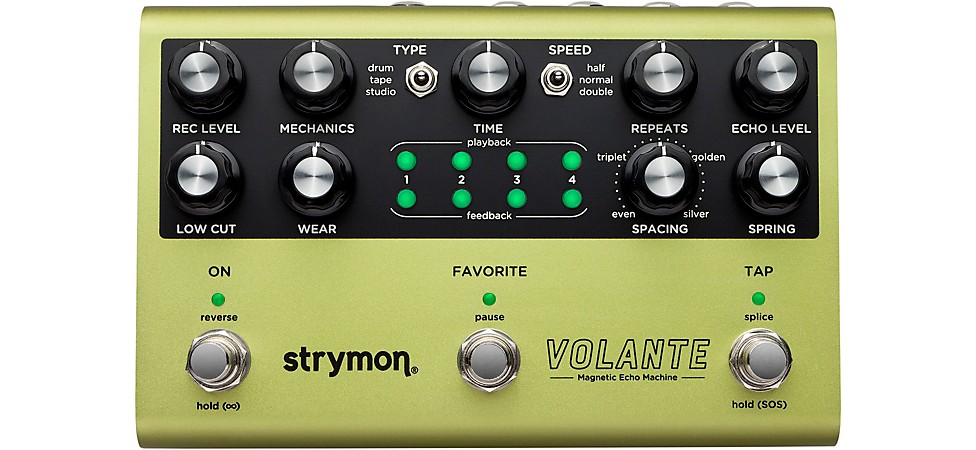
Shop Now: Strymon Volante Magnetic Echo Machine Effects Pedal
We often take delay for granted as a rudimentary effect by today’s digital production standards. But when you’ve had the opportunity to experiment with vintage echo machines and their charming quirks, delay’s creative potential can be fully realized. The Strymon Volante Magnetic Echo Machine pedal meticulously emulates three distinct retro delay generators, offering guitarists the beautifully saturated sounds of magnetic drum echo; the complexity of vintage tape delay with all of its mechanical noise and instability; and the clean, hi-fi quality of studio reel-to-reel decks. Above all, the Strymon Volante brings timeless analog character to your pedalboard, so you can craft expansive universes of sound with the musical warmth and organic richness our ears crave.
Strymon pedals are renowned for their exceptionally detailed sound. Stop by our Guide to Strymon Pedals if you’re keen to deck out your entire board with impeccable effects.
Key Players and Featured Tracks
The following are curated selections by some of progressive rock and metal’s most pivotal players, whether you’re dipping your toes into the proverbial prog waters for the first time or you’re a longtime listener.

Pictured: Keeley Dark Side Multi-Effects Pedal
Pink Floyd—"A Saucerful of Secrets" (1968)
The title track from Pink Floyd’s sophomore album is an instrumental composition, initially sequenced through diagrams drawn on scraps of paper by Roger Waters. The tune features Farfisa and Hammond organ, Mellotron, piano and vibraphone played by Richard Wright; bass guitar and cymbals from Roger Waters; slide guitar from David Gilmour; and drums and chimes by Nick Mason. An ambient, dissonant instrumental, the song’s final few minutes resolve with celestial chants over an organ progression.
King Crimson—"21st Century Schizoid Man" (1969)
King Crimson’s “signature” song debuted in 1969 on their first album In the Court of the Crimson King. Blending the rowdiness of rock, improvisational inklings of jazz and careful composition of classical, the song is a prog masterpiece and often considered a very early precursor to heavy metal. In 2008, Guitar World rated Robert Fripp’s dissonant guitar solo #82 on their list of the “Top 100 Greatest Guitar Solos.”
Yes—"Heart of the Sunrise" (1971)
Closing out Yes’ fourth studio album Fragile, “Heart of the Sunrise” opens with a groovy Chris Squire bassline in 6/8 time before cycling through various movements, including those in 4/4, 5/8 and 9/8. Steve Howe’s frantically paced guitar parts, accompanied almost in unison by Squire, eventually give way to the song’s first dreamy verse highlighting, Jon Anderson’s vocals. Bill Bruford’s expert timekeeping and Rick Wakeman’s Hammon organ, Mellotron and Minimoog soundscapes tie the entire piece together. The track’s opening sequence is featured in the cult-classic film Buffalo ’66 by Vincent Gallo.
Camel—"Song Within a Song" (1976)
Fronted by guitarist, flutist and vocalist Andrew Latimer, Camel is an influential, if occasionally overlooked, progressive rock band. This track comes from the group’s fourth album Moonmadness and pivots between mellow, atmospheric verses featuring Latimer’s delicate flute lines and somber vocals, as well as euphoric, guitar- and keyboard-driven sections. In 2014, readers of Prog magazine voted Moonmadness #58 on the publication’s “Top 100 Prog Albums of All Time” list.
Rush—"Xanadu" (1977)
Rush’s fifth studio album A Farewell to Kings was the band’s first to make more extensive use of synthesizers, and each member also played more instruments than on previous efforts. For example, Geddy Lee played Minimoog and 12-string guitar, Alex Lifeson dabbled with bass pedal synths and Neil Peart contributed bells, chimes, triangle and more. The 11-minute “Xanadu” opens with an approximately five-minute long instrumental section before Lee’s vocal narrative begins, with lyrics inspired by the Samuel Taylor Coleridge poem “Kubla Khan: or A Vision in a Dream.”
Tool—"Eulogy" (1996)
Following the success of their debut full-length album Undertow in 1993, alternative and progressive metal icons Tool catapulted into the mainstream with 1996’s Ænima, which made landfall at #2 on the Billboard 200. “Eulogy” is an eight-minute exploration showcasing the band’s penchant for extended arrangements and complex rhythms juxtaposed with heavy, groovy, and above all, catchy hooks.
Radiohead—"Paranoid Android" (1997)
The lead single from Radiohead’s landmark OK Computer, “Paranoid Android” is a six-minute composition with parts folded together from three distinct working songs at the time. A critically acclaimed hit, the tune recalls “Bohemian Rhapsody” by Queen, “Happiness Is a Warm Gun” by the Beatles and elements of the Pixies’ catalog as its spiritual predecessors. Interestingly, “Paranoid Android” was originally 14 minutes long with an extended Hammond organ outro by Jonny Greenwood—Thom Yorke jokingly called this early iteration a “Pink Floyd cover.”
Dream Theater—"Scene Six: Home" (1999)
Metropolis Pt. 2: Scenes From a Memory is progressive metal juggernaut Dream Theater’s fifth full-length, first concept album and sequel to the song “Metropolis Pt. 1: ‘The Miracle and the Sleeper’” from their sophomore release Images and Words. In 2015, Rolling Stone ranked Scenes From a Memory #29 on a list of the “50 Greatest Prog Rock Albums of All Time.”
Opeth—"The Leper Affinity" (2001)
Swedish progressive death metal masterminds Opeth released their breakthrough fifth studio album Blackwater Park in 2001, positioning “The Leper Affinity” as its opening track. Extreme metal at its core, the critically acclaimed record also relies heavily on gentler acoustic elements and clean vocals, all within a single, carefully arranged composition—which “The Leper Affinity” demonstrates.
It’s worth noting the album was produced by modern prog hero Steven Wilson, who helped hone in on the distinctly progressive elements of frontman and primary songwriter Mikael Åkerfeldt’s style. In the 2010s, Opeth embarked on a string of albums leaning into the band’s prog rock—not metal—side, notably ditching the growled vocals and brutal riffing heard in previous efforts.
The Mars Volta—"Cicatriz ESP" (2003)
The Mars Volta should be included in any conversation about 21st-century progressive music, in which vocalist Cedric Bixler-Zavala and guitarist/songwriter Omar Rodriguez-López have seamlessly fused Latin, jazz and punk influences with oft-frenzied, occasionally spaced-out prog rock. The Mars Volta’s 2003 debut De-Loused in the Comatorium—from which this track comes—is widely considered their magnum opus.
Porcupine Tree—"Arriving Somewhere But Not Here" (2005)
Founded by multi-instrumentalist, producer and songwriter Steven Wilson in 1987, Porcupine Tree can be credited as the quintessential progressive rock outfit of the post-1970s era. 2005’s Deadwing is a loose concept album based on an unrealized screenplay by Steven Wilson and Mike Bennion—a surrealistic ghost story influenced by Stanley Kubrick and David Lynch. “Arriving Somewhere But Not Here” was originally intended for the movie’s soundtrack, which was never made. The song features backing vocals and a guitar solo by Opeth’s Mikael Åkerfeldt.
Steven Wilson—"No Twilight Within the Courts of the Sun" (2008)
In 2008, Steven Wilson kicked off a prolific, ongoing solo career with Insurgentes. At the time of release, Wilson considered the album among the most experimental work he’d done with “song-based” music. This track features Tony Levin on bass and Jordan Rudess on piano, in addition to longtime Porcupine Tree drummer Gavin Harrison.
Periphery—"Reptile" (2019)
Contemporary prog metal sweethearts Periphery continuously explore the depths of their creativity as pioneers of what fans and peers colloquially refer to as the “djent” scene. At 16 minutes and 44 seconds, “Reptile”—the opening track from Periphery IV: HAIL STAN—is the band’s longest composition to date. Featuring a seamless blend of the collective’s biggest influences, from symphonic black metal to ambient electronic, “Reptile” takes listeners on a winding, slithering journey.
Plini—"I'll Tell You Someday" (2020)
Fusing elements of progressive metal, jazz fusion and electronic rock, Sydney-based guitarist and composer Plini earns the title of one of instrumental prog’s brightest luminaries. He puts virtuosic musicianship to outstanding melodic and compositional use, leaning into his technical ability without ever appearing self-indulgent. Back in 2016, the legendary Steve Vai expressed delight “that the future of exceptional guitar playing was secure” in Plini’s hands.
Careful With That Axe, Eugene
The vast, varied realm of prog rock welcomes out-of-the-box thinking and unconventional approaches to songwriting and musicianship. Apart from core rock guitar sounds—which include a nice, sparkling clean and an overdriven crunch—the rest of your tonal repertoire is left to the imagination. Consider established effects like fuzz, chorus, phaser, delay and reverb as good starting points to move beyond your “stock” guitar and amp tones, but don’t be afraid to get in the lab and conjure up some original brews.
As always, the doors to your local Guitar Center are open to come in and test drive some of the best gear for prog rock guitarists firsthand. If you have any further questions, our experienced Gear Advisers are online and at the phone to field those inquiries.

Pictured: Mesa/Boogie Mark VII 90W 1x12 Tube Combo Amp
People Also Ask ...
What are the best guitars for prog metal?
The best guitars for progressive metal are fast and easy to play, and have versatile pickup and electronics layouts (HH with coil splitting, HSH and HSS, for example) to handle cleans, mid-gain tones and fully saturated fury. We’ve compiled a list of some of the Best Metal Guitars to help you narrow the list.
What are the best guitar amps for prog metal?
As with any subgenre of metal, a high-gain amplifier with brutal onboard distortion is the first place to start. From here, you should also consider an amp with a quality clean channel to reproduce the atmospheric ambience heard in lots of today’s progressive metal. Check out our guide on the Best Guitar Amps for Metal for a well-rounded list of go-to choices and underrated favorites.
What instruments are played in prog rock?
Classic prog rock instrumentation usually consists of electric guitar, bass, keyboards and synthesizers (like the Moog Minimoog Model D, Mellotron, Hammond organ, Fender Rhodes and Wurlitzer), drums and vocals. Sometimes groups feature wind instruments, including flute and saxophone, as well as orchestral elements like strings.
Is Led Zeppelin a prog rock band?
Led Zeppelin is arguably one of the most forward-thinking, progressive bands in history, though they’re seldom attributed the “prog rock” label outright. Between Jimmy Page’s violin-bowed guitar parts on “Dazed and Confused”; Robert Plant’s Tolkien-inspired fantasy lyrics throughout the band’s catalog (heard on songs like “Ramble On,” “The Battle of Evermore” and “Misty Mountain Hop”); John Paul Jones’ extensive (and impressive) synthesizer and keyboard playing on In Through the Out Door; and epic-length tracks, including “Stairway to Heaven” and “In My Time of Dying,” Led Zeppelin is unquestionably more than your run-of-the-mill rock band.
To emulate Jimmy Page’s iconic guitar sounds, check out his signature “Dragon” Fender Telecaster, the Marshall 1959HW Handwired Plexi and a ’50s- or ’60s-style Gibson Les Paul Standard, in addition to the VOX V846 wah pedal, Dunlop Echoplex delay and Warm Audio Warm Bender fuzz.





